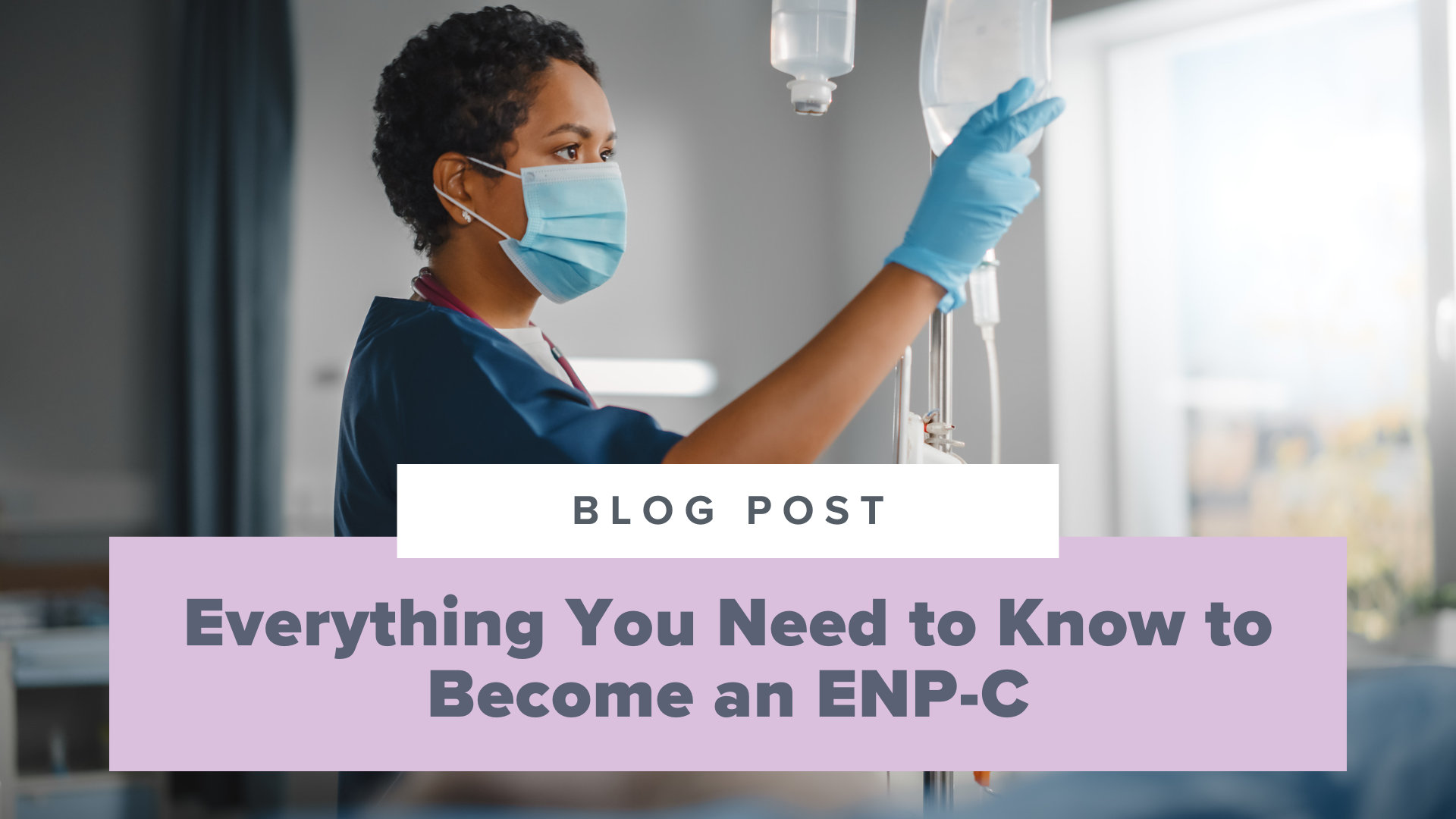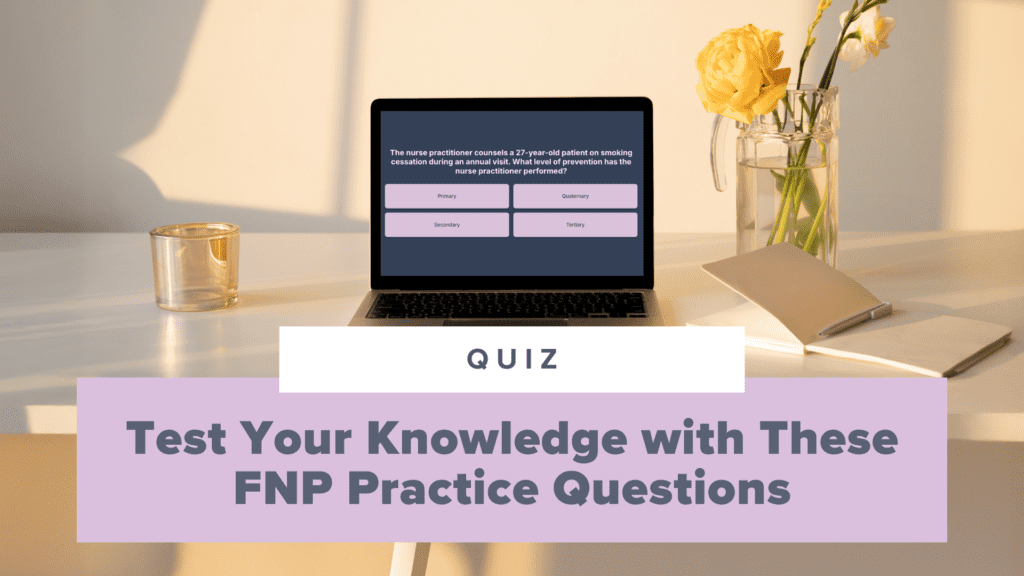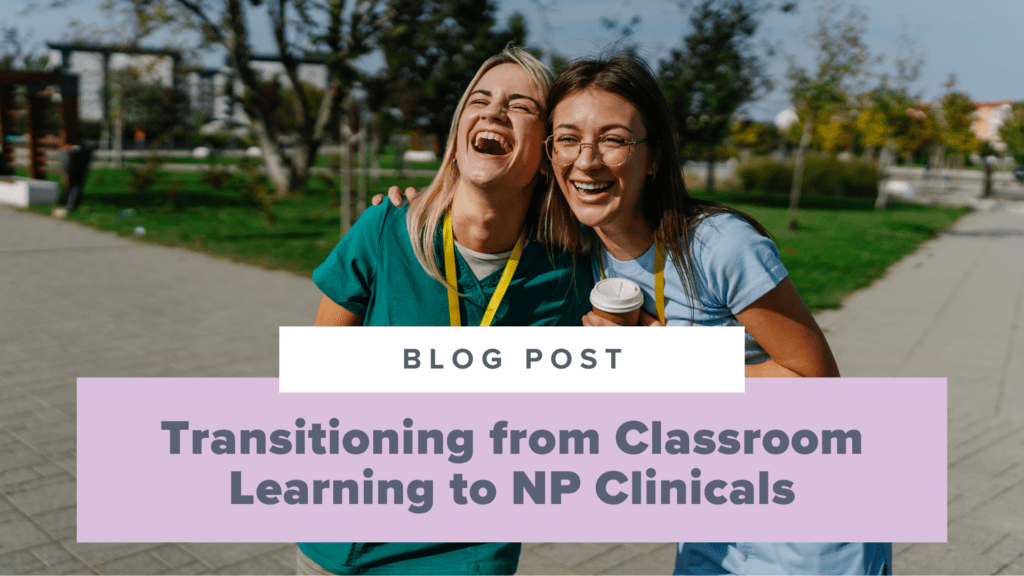Everything You Need to Know to Become a Certified Emergency Nurse Practitioner (ENP-C)
- by
- Jul 31, 2024
- Articles

👋 Hey there future real-deal nurse practitioners—Ashton here, an SMNP instructor! I’m also a certified emergency nurse practitioner (ENP-C).
So, you want to become a real-deal ENP-C? You’ve come to the right place! In this post, we’ll discuss everything you need to know along the journey to emergency health care ENP certification. 🩺
Before we dive in though, here’s a bit of history about the specialty and how it came to be in the first place! In January 2017, the American Academy of Nurse Practitioners Certification Board (AANPCB) together with the American Academy of Emergency Nurse Practitioners (AAENP) launched the first of its kind ENP certification exam. Successful completion of the exam will earn you the ENP certification, or ENP-C.
With that said, there are a few things you need to know about who’s eligible to take the exam first!
How do you become eligible for the ENP certification exam?
To sit for the ENP certification exam, you’ll need the following:
1. A current, active, registered nurse license in the US, US territories, or a Canadian province or territory
2. A current national certification as a family nurse practitioner (FNP)
3. Emergency care specialty content that includes at least one of the following options:
Option 1
– A minimum of 2,000 direct, emergency care clinical practice hours as a Family NP in the past five years
– Evidence of 100 hours of continuing emergency care education (CEs)
– Of those 100 hours, a minimum of 30 must be emergency care procedural skills
Option 2
– Completion of an approved graduate or postgraduate academic emergency nurse practitioner program
Option 3
– Completion of an approved emergency fellowship program
Let’s take a closer look at Option 1!
Option 1: Continuing Education
What do we mean by continuing emergency care education, and how do these CEs differ from those used to maintain your FNP certification?
Appropriate educational programs focus on topics like emergency or urgent care medical screening, decision-making, differential diagnosis, patient management, disposition, and professional, legal, or ethical issues related to ENP practice. All of the CEs used to qualify for the ENP examination can also be used for FNP certification renewal for those certified by the AANPCB.
Procedural Skills
Next, let’s have a look at the requirements for emergency care procedural skills!
Procedural skills and clinical experience include education course content for FNPs that includes (but isn’t limited to) CE credits for the following:
– Suturing
– Lumbar puncture
– Thoracentesis
– Chest tube placement and management
– Paracentesis
– Advanced vascular access
– Fracture and joint reduction
– Nail removal and repair
– Local and regional anesthesia techniques
– Wound management and incision and drainage
– Diagnostic and procedural ultrasound
*According to the AANPCB, credits obtained from the following advanced life support courses are accepted:
– Advanced Burn Life Support (ABLS)
– Advanced Life Support in Obstetrics (ALSO)
– Advanced Trauma Life Support (ATLS)
– Neonatal Resuscitation Program (NRP)
– Advanced Trauma Life Support (ATLS)
*ACLS, PALS, and BLS courses aren’t accepted.
One thing it’s important to know is that all continuing education credits and certification programs have to be from an approved CE provider, such as the American Association of Nurse Practitioners (AANP) or American College of Emergency Physicians (ACEP). Education programs that don’t have the right CE credits won’t count towards your procedural skills.
Here’s a list of procedural skills provided by the AANPCB.
Be sure to check out our ENP Emergency Care Skills & Procedures Module Qbank, which includes 30 AMA PRA Cat 1 procedure credits and satisfies the emergency care procedural skills requirement for Option 1!
Options 2 & 3: ENP Training Programs vs. Fellowship Programs
Now, let’s take a closer look at Option 2 and Option 3!
You can take the ENP certification exam after you complete an academic emergency care graduate or postgraduate NP program.
The AAENP maintains a list of ENP training programs on their website.
The real difference between ENP training programs and ENP fellowship programs lies in their structure and target audience. ENP training programs (Option 2) include emergency care components from the beginning, providing entry-level academic preparation for NPs to practice in emergency care settings.
To contrast, ENP fellowship programs are for NPs who’ve already obtained their NP degree and want to specialize further in emergency care.
So, NPs who go on to do an ENP fellowship meet Option 3 for exam eligibility!
What’s on the ENP certification exam?
Once you determine your eligibility, you’ll want to get ready for the ENP certification exam!
Here’s what the AANPCB says about exam content:
– The ENP certification exam tests clinical knowledge of emergency care needed for an entry-level ENP-C. The focus is on providing care for the family/individual across the lifespan, including prenatal, pediatric, adolescent, adult, and older adult.
– Content outlines tell you the proportion of exam questions that are on each topic. Percentages are used to determine the number of test questions on each subject and task that are on the exam.
– Specific age ranges aren’t defined for any population. The AANPCB uses growth and development as the basis of age-related questions instead.
ENP Certification Exam Content
According to the AANPCB, there are 150 questions on the ENP certification exam. However, 15 questions are considered pretest questions, meaning they aren’t scored. (You won’t be able to tell the difference between the pretest and scored questions, so just know that not all of the questions will affect your score!)
Here’s a breakdown of what’s on the ENP certification exam:
| Domain I* (Domains) | % of ENP Exam | # of Scored Items (135) |
| 01 – Medical screening | 16% | 21 |
| 02 – Medical decision making/differential Diagnosis | 24% | 33 |
| 03 – Patient management | 36% | 48 |
| 04 – Transitions of care | 16% | 22 |
| 05 – Professional practices | 8% | 11 |
| TOTAL | 100 | 135 |
*See below for domain detail.
Domains and Tasks
DOMAIN 01: Medical Screening
– Perform a focused history and physical exam based on the chief complaint.
– Establish patient acuity level to determine need for rapid intervention.
DOMAIN 02: Medical Decision Making / Differential Diagnosis
– Identify differential diagnoses based on what’s most likely.
– Prioritize differential diagnoses, taking into account risk of morbidity or mortality.
– Evaluate diagnostic studies based on the differential diagnoses.
DOMAIN 03: Patient Management
– Rapidly intervene to resuscitate/stabilize the patient.
– Prescribe the right pharmacologic agents.
– Initiate non-pharmacologic therapeutic interventions.
– Perform diagnostic and therapeutic procedures/skills.
– Consult with other healthcare providers to optimize patient management.
– Reevaluate for changes in the patient’s condition.
– Prioritize and manage multiple patients of varying acuity simultaneously.
DOMAIN 04: Transitions of Care
– Determine the correct and timely patient disposition including admission, discharge, observation, or transfer as appropriate.
– Formulate a specific disposition plan with the right resource utilization.
– Engage the patient and/or caregiver to effectively coordinate transitions of care.
DOMAIN 05: Professional Practices
– Integrate diverse, equitable, and inclusive practices into patient management.
– Manage the unique needs of vulnerable populations.
– Demonstrate knowledge of Emergency Medical Treatment & Labor Act (EMTALA) regulations.
– Adhere to professional, ethical, quality, safety, and regulatory/legal standards in emergency care.
Patient Conditions or Type
| Domain II – Patient Conditions | % of ENP Exam | # of Scored Items (out of 135) |
| Thoracic/respiratory disorders | 10% | 14 |
| Cardiovascular disorders | 11% | 15 |
| Cutaneous disorders | 6% | 7 |
| Abdominal and GI disorders | 13% | 17 |
| Musculoskeletal disorders (nontraumatic) | 7% | 10 |
| Renal/Genitourinary disorders | 7% | 9 |
| Neurological disorders | 6% | 8 |
| HEENT disorders | 8% | 11 |
| Traumatic disorders | 8% | 11 |
| Psychobehavioral disorders | 6% | 8 |
| Obstetrics and gynecology | 5% | 7 |
| Environmental and toxicological disorders | 3% | 4 |
| Systemic infections and hematologic and immune system disorders | 5% | 7 |
| Endocrine, metabolic, and nutritional disorders | 5% | 7 |
| TOTAL | 100 | 135 |
Knowledge Areas
– Anatomy, physiology, and pathophysiology
– Medical screening examination
– Focused health history and physical
– Differential diagnosis/medical decision-making
– Diagnostic studies (e.g., EKG, radiology, body fluid)
– Diagnostic/therapeutic procedures
– Pharmacological therapies
– Integrative therapies
– Consultation and collaboration
– Patient and family education and counseling
– Resource utilization
– Documentation (e.g., coding, billing)
– Professional, ethical, quality, and regulatory/legal issues
– Prehospital and EMS
– Health equity
– Vulnerable populations
– Principles of epidemiology, population health, and social determinants of health
– Safety and harm reduction
– Disaster and mass casualty management
– Resuscitation and stabilization
– Prioritization
– Disposition
– Forensics
How is the exam scored and what is the passing score?
The AANPCB reports the ENP exam as a scaled score ranging between 200-800 points, with the minimum passing score being 500.
You can get a preliminary pass or fail status at the testing center upon finishing the exam, even before receiving your scaled score. A preliminary pass from the testing site isn’t an official notification, doesn’t indicate active certification status, and CAN’T be used for employment or licensure as an NP.
As of 2023, the ENP exam pass rate was 86%. This marks a decline from the 89% pass rate in 2022, and the 90% pass rate in 2021.
How do you study for the ENP certification exam?
When I was prepping for my ENP exam, I exclusively used the SMNP Reviews (formerly Rosh Review) Qbank and I passed with flying colors on my very first attempt! I felt very prepared going into the exam and confident in my answer choices.
Study Resources and ENP Qbank
The SMNP Reviews ENP Certification Qbank was created specifically to help learners pass the ENP certification exam! It’s the ultimate resource built specifically to help ENP students ace their exams on the first try.
The Qbank features 2,100 board-style questions meticulously crafted and peer-reviewed by a team of ENP-Cs such as myself, who’ve been in your shoes and understand the intricacies of the exams!
And you don’t just get practice test questions—each question includes detailed explanations (for both incorrect and correct answer choices) and handcrafted illustrations for a visual learning experience.
Here’s an example:
Also, your personal analytics dashboard empowers your test prep by tracking your progress, providing your probability of passing, and uncovering the content areas that need more work. This powerful tool will help you stay focused on what matters most and ensure the most efficient use of your study time!
For those moments when you need some guidance on the road to becoming an ENP-C, you can contact our expert support staff to receive the help you need. Whether you’re stuck on a tricky, high-yield topic or just need some words of encouragement, our ENP-C experts have your back!
Need a quick summary? Our questions also feature Rapid Reviews that provide concise summaries of the main topic at hand. Top it off with a quick bonus question, also known as our One Step Further question, which accompanies each ENP certification practice question.
Last but not least, you’ll also earn 100 American Medical Association (AMA) Physician’s Recognition Award (PRA) Category 1 Credit(s)™ after finishing the Qbank!
We know there are limited resources out there to prepare for the ENP certification exam, so SMNP Reviews has made it easy. You can trust us, or sign up for a free trial! Whichever you decide, we’re here to help!
This is an exciting time to become an ENP-C, and it’s a privilege for us at SMNP Reviews to play a small role in supporting the education of future ENPs.
Keep working hard to become an ENP-C and always have a sense of mission for your work!
Check out our other blog posts for NP students!
- Top 10 Questions About Emergency Nurse Practitioner Qbanks & the Certification Exam
- Top Test-Taking Secrets for Your NP Board Exam
- [Podcast] How to Succeed on Your First Day as a New NP
Best,
Ashton Glover, DNP, FNP-C, ENP-C
—
At SMNP Reviews, we believe in empowering our NP community with the knowledge and skills they need to become successful, confident nurse practitioners. That’s why we’ve created this blog to provide you with all the resources you need to stay up-to-date with the latest and greatest information to help you excel in your career. Our goal is to make your lives easier by creating a hub where you can find, explore, and delve into the plethora of resources we offer.
Content modified from the AANPCB and AAENP websites.
Of note: Effective January 2017 the American Academy of Nurse Practitioners National Certification Board, Inc. changed its business name from AANP Certification Program (AANPCP) to the American Academy of Nurse Practitioners Certification Board (AANPCB).
Search the Blog
Join our Facebook Group!
Get FREE support and encouragement from thousands of FNP/AGPCNP students and our NP Support team.
Learn More3 Study Hacks to Conquer Your NP Exam!
Download these tips that have helped thousands of students pass their NP board exams.
Download NowInstitutional Partnerships
Are you a faculty member and would like to bring Sarah Michelle’s resources to your school? Email us at nursinggroups@blueprintprep.com for special institutional pricing or click on the link below to learn more.
Learn MoreGroup Discounts
Are you a student and have 10 or more classmates interested in purchasing Sarah Michelle’s courses? Email us at nursinggroups@blueprintprep.com for special pricing.




